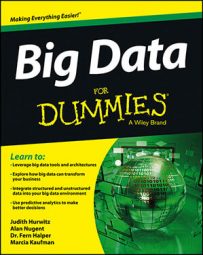What does the business plan hope to achieve by leveraging big data? This is not an easy question to answer. Different companies in different industries need to manage their data differently. But some common business issues are at the center of the way that big data is being considered as a way to both plan and execute for business strategy.
The greatest challenge for the business is to be able to look into the future and anticipate what might change and why. Companies want to be able to make informed decisions in a faster and more efficient manner.
Stage 1: Plan with big data
With the amount of data available to the business, dangers exist in making assumptions based on a single view of data. The only way to make sure that business leaders are taking a balanced perspective on all the elements of the business is to have a clear understanding of how these data sources are related.
But companies typically only have a small amount of the data they will need to make informed decisions. The business needs a road map for determining what data is needed to plan for new strategies and new directions.
For example, if your company needs to expand the type of services it offers to existing customers, you need to analyze as much data as possible about what customers are buying and how that is changing. What do customers like and dislike about products? What are competitors offering?
If you find ways to effectively manage the data, you may be able to have a powerful planning tool. While the data may confirm your existing strategy, it might send you in new unexpected directions. Part of your planning process requires that you use a variety of data to test assumptions and think differently about the business.
Stage 2: Do the analysis
After your organization understands the business objectives, it is time to begin analyzing the data. This is not a stand-alone process. Executing on big data analysis requires learning a set of new tools and skills. Many organizations will need to hire some big data scientists who can take this massive amount of disparate data and understand how all the elements relate in the context of the business problem or opportunity.
Big data analytics is a dynamic area that is experiencing very rapid change. Combining the immaturity of the analytics with the needs of business to continually add new data sources that need to be added into the analytics approach will put a lot of pressure on the business to push the boundaries of what is possible.
The businesses that are able to get a handle on applying big data analytics to their business planning will be able to identify business nuances and changes that can impact the bottom line. For example, if your company is in the e-commerce market, you will want to analyze the results of new partnerships to see whether they are generating both customer interest and new sales.
You may want to see the reaction to the new services on social media sites. At the same time, you want to have a clear understanding of what your closest competitors are offering that could impact revenue.
Stage 3: Check the big data results
It is easy to get caught up in the process of analyzing data and forget to do a reality check. Does the analysis reflect business outcomes? Is the data you are using accurate enough or do problems exist? Are the data sources going to truly help with planning?
This is the time to make sure that you are not relying on data sources that will take you in the wrong direction. Many companies will use third-party data sources and may not take the time to vet the quality of the data. When you are planning and making business decisions based on analysis, you have to make sure that you are on a strong foundation.
Stage 4: Act on the big data plan
After this cycle of analysis is complete, it is time to put the plan into action. But actions have to be part of an overall planning cycle that is repeated — especially as markets become more dynamic. Each time a business initiates a new strategy, it is critical to constantly create a big data business evaluation cycle.
This approach of acting based on results of big data analytics and then testing the results is the key to success. Big data adds the critical element of being able to leverage real results to verify that a strategy is working as intended. In some cases, this will mean resetting the strategy. In other situations, the unintended consequences will lead a company in a new direction with a better outcome.

